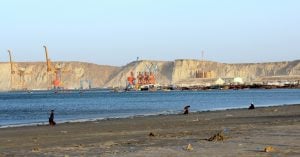With the Trump administration thinking about taking the US out of the Paris Agreement and already rolling back domestic climate policies, all eyes have turned to China and whether the world’s largest emitter can occupy the leadership void left by the US.
President Xi Jinping has called the 2015 Paris Agreement a “milestone in the history of climate governance” and has pledged to implement China’s commitments under it. But, as Joanna Lewis and Li Shuo have written in China Dialogue, global leadership requires more than just doing one’s part at home. It requires articulating a broader vision and bringing others aboard through incentives and inducements.
The question is how. China’s diplomatic stance is unlikely to change overnight. Therefore, to realise the government’s ambition to become a leader in global governance, and to safeguard the “hard-won achievement” of the Paris Agreement, China must find new avenues for climate leadership. Fortunately, as Angel Hsu and Carlin Rosengarten also note in chinadialogue, traditional diplomatic leadership can be supplemented by “leading by doing.” Indeed, in the evolving climate regime, “leading by doing” has become much more important. In this context, non-traditional channels of diplomatic influence – networks of cities and business, and overseas infrastructure investment – offer concrete steps forward for China.
Leadership starts at home
Despite rhetorical claims to leadership and support for the Paris Agreement, there are as of yet no signs China will actively push diplomatically for a stronger international climate regime, or lean on other countries to increase their own climate ambitions. Because such steps would be a major diplomatic departure for China, they will likely only emerge slowly, if at all. Nor is it likely that China will formally increase the pledge it made at Paris to peak emissions by 2030.
So how can China play a more progressive and assertive position in global climate policy? There is an urgent need to find new ways for China to exercise climate leadership beyond traditional diplomacy. Fortunately, the government has new tools at its disposal.
Potential for bottom-up action
It’s not just national governments that are taking action on climate. Cities, companies, civil society groups, and other sub/non-state actors are also addressing climate change (now captured on the UN’s NAZCA platform). The 2015 UN Climate Conference in Paris brought this “groundswell” of non-state climate action into the heart of the intergovernmental regime.
While this shift represents an important breakthrough, it also faces a crucial challenge. Most of the world’s future emissions will come from developing countries, which will also experience the worst effects of climate change. Yet research shows that most non-state climate action is still concentrated in developed countries, and the vast majority of bottom up climate initiatives, which link sub- and non-state actors across borders, are initiated and led by Northern actors.
At the international level, China appears to fall far behind. Though its emissions are five times greater than India, twice as many Indian cities, states, companies, and other sub/non-state actors are taking climate action in transnational networks than Chinese counterparts.
Yet there is an enormous amount of activity on climate change at the sub-national level in China, as well as in both state-owned and private companies. For example, the Alliance of Peaking Pioneer Cities aim to peak their city emissions in advance of national targets. However, most of this action is not connected to international networks. Therefore the Chinese government has a major opportunity to reinforce its domestic policies and signal international leadership by facilitating a greater role for Chinese sub/non-state actors in transnational networks.
Bringing Chinese cities, provinces, and businesses more forcefully into the various transnational climate action networks (e.g. C40, We Mean Business, the Compact of States and Regions, etc.) could rapidly expand the heft of these transnational networks while bringing critical information, relationships, and financing opportunities to Chinese sub- and non-state actors.
In this way China could expand its international climate leadership rapidly without substantially altering its traditional negotiating stance. A strong signal from Beijing to embrace these networks would also encourage further climate action from Chinese cities, provinces, and companies, and link them to their peers around the world, particularly in other parts of the Global South.
Some may fear that a “bottom up” emphasis would shift authority from the central government to local governments and companies. But this concern is misplaced. The voluntary and collaborative nature of city and business networks means they cannot threaten national sovereignty. On the contrary, they help national governments deliver their pledged targets more efficiently, while bolstering their countries’ diplomatic positions by showing tangible evidence of progress.
Greening outbound infrastructure investment
China is emerging as the largest source of infrastructure investment for many countries. Through institutions and initiatives like the Asian Infrastructure and Investment Bank (AIIB), the New Development Bank (NDB), the One Belt One Road initiative, the lending of the Chinese Development Bank, and the activities of its large commercial banks and infrastructure companies, China will play a decisive role in the infrastructure choices that many countries make over the critical next several years.
To be blunt, if this influence serves to lock in carbon-intensive choices, it will effectively kill efforts to reach the Paris Agreement’s goals. But it also has the potential to provide the lion’s share of the trillions of clean investment required over the next decades to decarbonise the world economy.
Fortunately, China is taking green finance seriously. Some of the AIIB’s and NDB’s first projects have been in renewable energy. AIIB’s environmental and social safeguards explicitly reference climate change. And international partners (e.g. UNEP, Bank of England, etc.) are working with Chinese financial institutions to support such projects and policies.
But China must not only encourage and support new green finance leaders, it must also prevent laggards from offloading low-quality, polluting infrastructure onto other developing economies. For example, this means reining in companies that build thermal coal power plants, which, facing constraints at home, are increasingly turning to markets in Southeast Asia and Africa.
Two concrete steps could radically advance Chinese leadership on this front. First, the government can go beyond rhetorical support for “green” infrastructure, and explicitly state that only projects in line with the Paris Agreement’s goals will be funded through the AIIB, the NDB, and especially the One Belt One Road initiative. Adding climate risk and a 2C compatibility test as an official selection criterion for new projects will send a powerful economic signal far beyond China’s borders.
Second, China should curtail high carbon, unproductive investments by Chinese firms abroad as aggressively as it does at home. Only by addressing the country’s overall overseas investment portfolio – not just the flagship green programmes – can China signal credible leadership on green finance.








